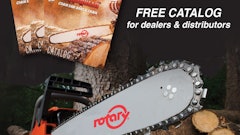
Long gone are the days of equipment and service selling itself. Dealers today have to work much harder to attract customers and get the sale. Mark and Patty Williams of Mark Williams Outdoor Power Equipment in Murphysboro, IL, decided that with a tough economy paired with an increasingly competitive and saturated marketplace, it was time they thought of new and innovative ways to operate. As their website states, “Through economic necessity comes innovation.”
They have continued to implement new and innovative programs to draw and retain customers, motivate staff and grow their sales. These assorted programs have made doing business with Mark Williams Outdoor Power Equipment a no-brainer and returned them to the forefront as a retailer.
Getting back what they lost
As the economy took a turn, Mark and Patty saw customers and manufacturers alike looking for inexpensive alternatives. While others were looking for ways to spend less, they were challenged with the task of drawing customers back to their dealership. Mark and Patty did this with less help from their manufacturers than they could typically count on in previous years.
“A lot of our manufacturers cut back on our co-op dollars,” says Patty. “When it happened, we had to figure out how we would recover that marketing budget.”
That was when they created the Shop & Share Program. The referral program designed to build goodwill and their customer base. It is simple to administer, rewarding local organizations with up to 6% of sales referrals.
“Our success is dependent on the support of our local community, much in the same way local organizations are dependent on the community,” says Patty.
Local not-for-profit groups are invited to participate in the Shop & Share Program. The dealership provides printed promotional materials for the organizations to distribute how they like. The materials (wallet cards, banners, T-shirts, flyers, etc.) promote that 6% of each sale referred by the organization goes right back to them.
“They are our ambassadors, in a sense, and only get out of it what they put in,” explains Patty. “It has worked out really well. We benefit a lot because we get to meet people from organizations within the community. It’s kind of a grassroots effort on our part and each year it grows.”
In addition to losing some co-op dollars from manufacturers, Mark and Patty also saw a dip in their parts sales to commercial customers. The commercial customers started looking to online retailers for the lowest parts price they could score, regardless of the quality in manufacturing. Mark and Patty had to find a way to compete with the low-overhead, price-competitive retailers.
“We noticed a decrease in common, over-the-counter maintenance parts sales,” says Patty. “We knew that our landscapers were purchasing these parts, but not from us. Our solution was to develop a landscaper purchasing program that would give us the opportunity to sell more parts.”
Landscapers were invited to join the new Parts Co-op Program. There is no annual membership fee. Members are simply required to purchase a maintenance kit at the discounted co-op price for their specific mower. The kit includes filters, blades, spark plugs and belts. All of the parts used in the co-op are quality OEM parts.
“We were competing with the internet and wanted to keep those sales and tax dollars in our local economy,” says Patty. “Our manufacturers got aggressive that year as well, and the planets aligned just right. We were able to buy at a discounted price and passed that onto our landscapers.”
Patty says the co-op program has saved their landscape customers over $8,000 since 2010, and has brought a lot of that parts business back to the dealership. In the first year, they saw a 15% increase in parts sales. The second year, sales fell flat. Patty says she will gladly take flat parts sales over the alternative, which is handing those sales back over to internet retailers.
“We felt OK about the flat year because it could have gone backwards,” explains Patty. “This year will be a hard one to measure because of the drought.”
The homeowner’s helper
With the commercial market under their belt, Mark and Patty started to focus on how to improve their relationships with the homeowner customer base. They saw customers skipping maintenance and lessening the life of their equipment in order to save on costs. While they could potentially benefit from a mower sale in the future, thanks to the lack of regular maintenance, they didn’t want the life of a product they sold to end before its time. They now offer regular classes to customers, educating them on simple equipment maintenance and troubleshooting.
“We didn’t want customers not doing the maintenance on their equipment because they couldn’t afford it,” says Patty. “We put some educational programs together so we could give our customers the tools to do it themselves. We have them and their equipment in mind. We don’t want them to lessen the life of their equipment because they can’t afford it.”
Each year they evaluate which classes they are offering customers to ensure they are truly providing quality, timely information. Classes are taught by Mark who operates the service department. The information he passes onto customers is often a reflection of what he has learned in manufacturer technician update courses. They also listen to customer feedback on the courses to learn how to improve what they offer and how.
“This year, customers needed to know more information on common operating problems and preventative maintenance,” explains Patty. “We also shared a lot on ethanol and carbonation issues.”
For those customers who still choose to have their equipment serviced at Mark Williams Outdoor Power Equipment, they offer the added convenience of an online service request form. It was implemented nearly two years ago to make it easier for customers to cross the task off their to-do list, and get that commitment for service from the customers as soon as it crosses their mind.
“Each year we see an increase in the use of this form,” says Patty. “We wanted to offer a way for our customers to request service 24 hours a day and be able to go to bed with that marked off their to-do list.”
Mainly homeowner customers use the form and Patty says it is just another way for the customer to contact them. They promote the online form in conversations with customers, in-store signage, and link to it in all email communications.
“We didn’t anticipate a lot of people going there, but as our website develops we expect to see more people use it,” says Patty. “We often refer customers to the website. In our email marketing we try to get people to think about their preseason service and they can click through the email to the online form immediately.”
Staff programs and support
All the different programs offered by Mark Williams Outdoor Power Equipment are on their website, markwilliamsoutdoor.com. Patty says she likes having them all in one place not only for the customer, but also employees. They can quickly and easily assist customers, with access to the programs and forms only a click away.
“Having the programs posted on the website helps with training,” she explains. “If we bring a new employee in, he can go to the website and get all the information he needs. There is no need to look for a file, it’s all right there. The website is not about buying things; it’s more about serving information to the customer.”
They have certainly given their staff the tools to better serve customers. An “allowance” program gives employees the opportunity to further their education and purchase tools and other things that will help them to improve on-the-job performance. With ever hour they work, each employee is earning toward their individual allowance.
“This allowance program can be used for tools in the shop, education, anything they feel will help them to better do their job,” explains Patty. “It can be something as simple as a pair of reading glasses, work boots, gloves or tools.”
Employees are also encouraged to use their allowance to take continued education courses in the offseason. The courses they choose to take do not have to relate to the industry or their work. “It helps them to think about things outside of the box,” says Patty. “We have not lost anybody to another field through offering the opportunity.”
Perhaps the reason employees stick around is the job satisfaction they receive working at Mark Williams Outdoor Power Equipment. They are given the tools for the job and then some. Recently, the dealership was also outfitted with a designated break room. A Wellness Program was also implemented.
“With being so seasonal, we put in long hours a lot of the time. It’s important to have a place to relax and sit down away from the phones and customers,” says Patty. “We’re not in a metropolitan area, so you can’t walk somewhere to eat lunch or go to a park. Everybody really appreciates that space.”
As part of their Wellness Program, the break room is typically stocked with fresh fruit and vegetables, and healthy snacks that employees are free to eat on a break or take home with them. Patty says it is a good way to keep employees healthy and mindful.
While some customers and manufacturers are cutting their spending, Mark and Patty continue to invest in their special programs that draw customers and take care of employees. A happy work environment often translates to better customer service, and in the end, higher sales.


























